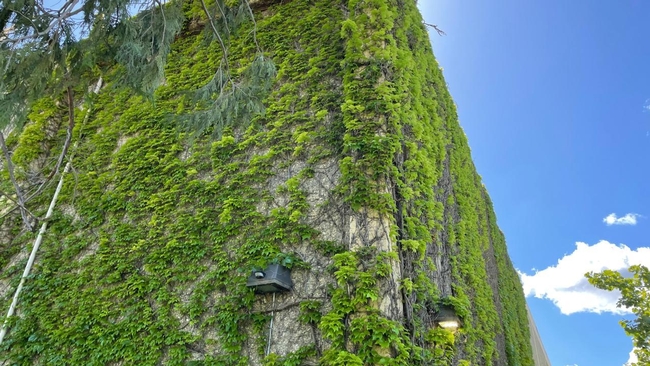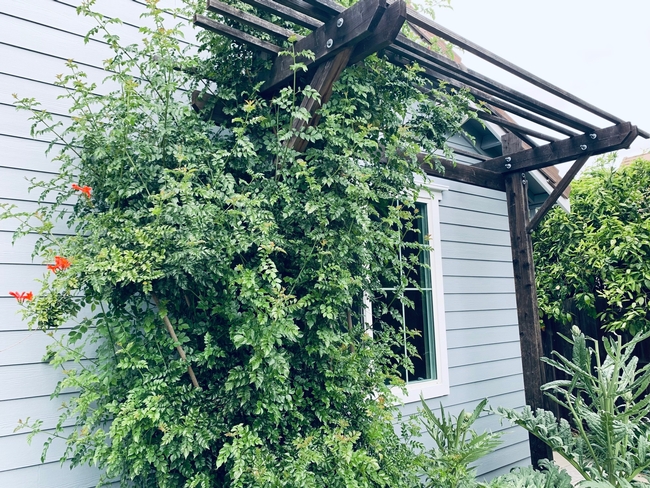Posts Tagged: vines
Can vines speed urban cooling?
Study explores cooling benefits of fast-growing vines as trees take their time
Perhaps trees aren't the only green solution when it comes to cooling urban spaces and reducing energy costs. Honeysuckle, Virginia creeper, pink trumpet and other vines could be a fast-growing substitute in climate-smart cities of the future.
Researchers from UC Davis are leading a nearly $880,000 federal grant to study how vines may provide cooling and shade in Western states in less time than it takes a tree to grow tall.
“Vines can quickly shade buildings and reduce energy consumption while trees slowly grow to maturity,” said Alessandro Ossola, an assistant professor of plant sciences who is a principal investigator for the project. “We believe vines can be an effective and cheap measure to help cities accelerating climate change adaptation.”
The grant from the U.S. Department of Agriculture's Agricultural Marketing Service will fund work to plant and monitor at least 10 types of vines on trellises in five locations in different climate zones over three years. California Department of Food and Agriculture is administering the grant.
Using less water
Water conservation will be vital as populations rise, climate extremes become more prevalent and the demand for agricultural and drinking water increases. The goal of this research is to identify vines that can help save energy by providing cooling and reduce the need for irrigated water.
“In addition to rapid growth rates, vines can be easily integrated with structures to maximize potential cooling effects,” said Loren Oki, a Cooperative Extension specialist with Department of Plant Sciences, who is the project lead. “But we need to understand the relationships between low water-use plants and their ability to reduce thermal loads on buildings.”
The vines will be planted, supported by a trellis and watered regularly during the first growing season to establish deep roots and healthy shoots. Over the next two years, the vines will experience low, moderate and high water allocations.
The vines will be rated on aesthetics, foliage quality, floral quantity, pest and disease resistance, appearance and other factors. Thermal images of trellis coverage and other environmental measurements will also be taken to assess shading and cooling potential, according to grant documents.
Many vines can be grown along cables and wire nets that are actually detached from walls to avoid direct contact and still provide shade, Ossola said.
“We want to understand which vine characteristics relate to fast growth, reduced water use and increased aesthetic appeal,” he added.
Outreach and education
The findings will enable recommendations to be developed for regions, planners, the landscape industry and the public. It could lead to plants being designated as “water-wise,” “low-water use,” “energy-saving” or “cooling.”
Extensive engagement and outreach will also publicize the information.
“Climate change is a great opportunity for the horticultural industry to innovate and promote climate-ready plant productions,” Ossola said.
USDA funding supports research across state lines to find innovative solutions to regional and national problems, USDA Under Secretary for Marketing and Regulatory Programs Jenny Lester Moffitt said in a news release announcing this and other grants.
“This year's funded projects will address a range of those challenges, from energy and water saving in vine plants, finding cost-effective solutions for heat tolerance and drought, to addressing food safety risks for produce,” Moffitt said.
Scientists from the University of Arizona, University of Washington, Utah State University and the South Coast Research and Extension Center at UC Agricultural and Natural Resources are contributing to the research and will be overseeing vine sites in their states.
This article is reprinted from the UC Davis College of Agricultural and Environmental (CA&ES) website, where it is titled "Could Vines Be the Answers to Speeding Urban Cooling, Water Reduction in the West?"


